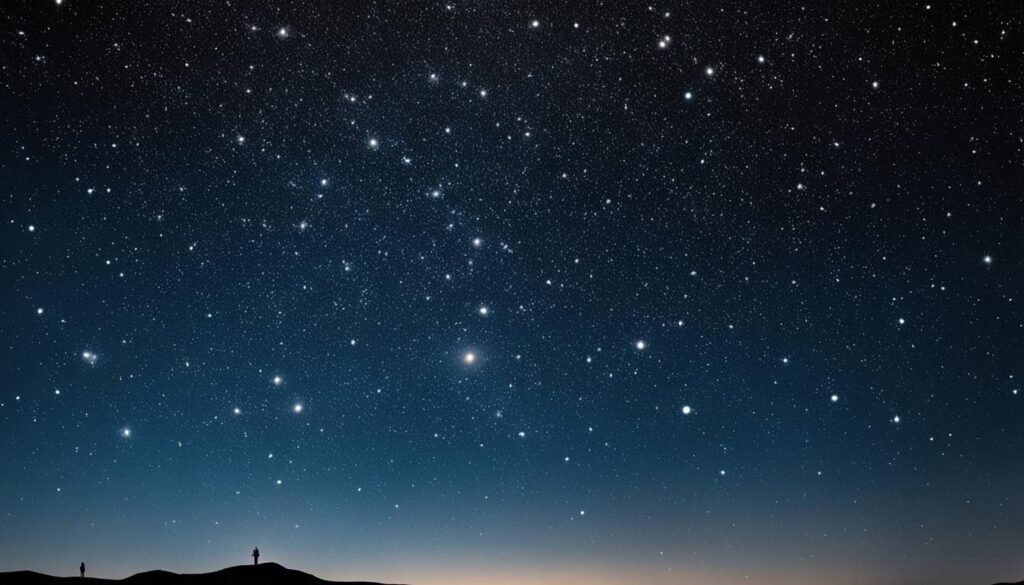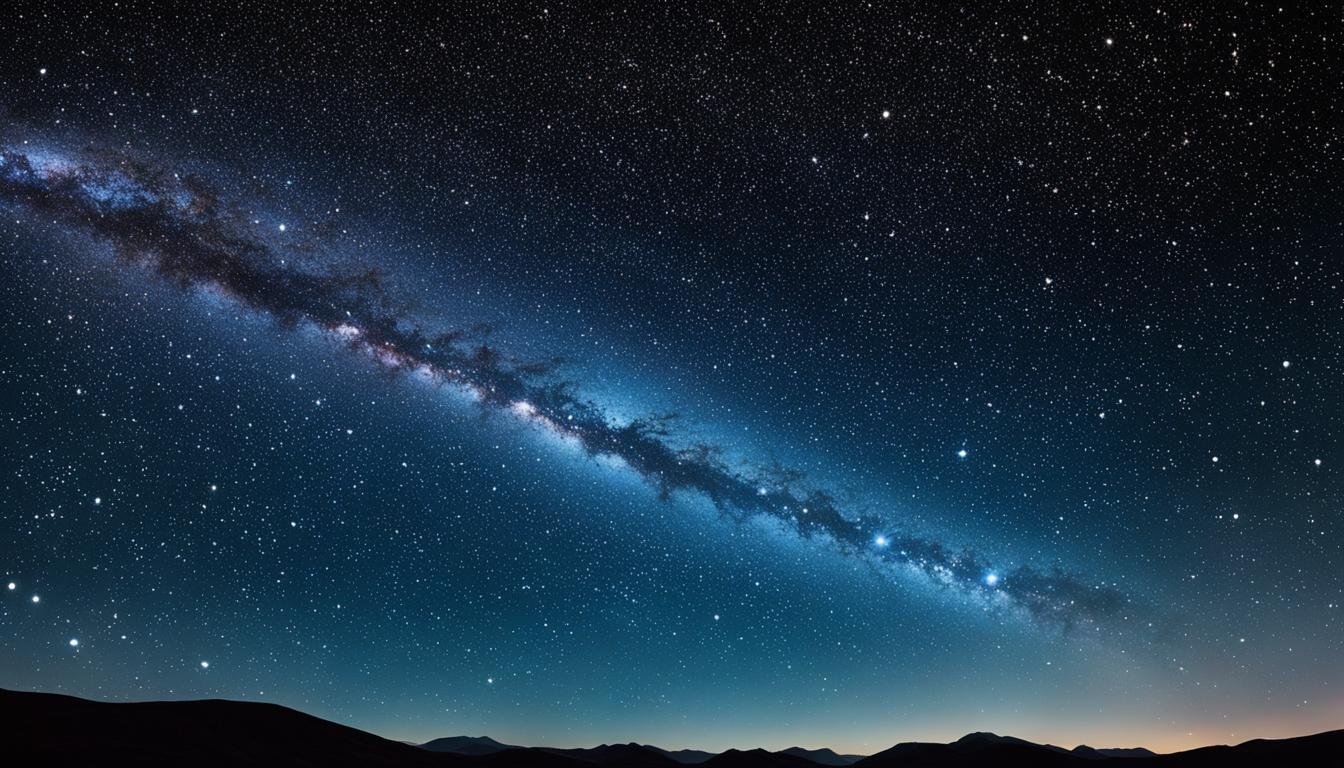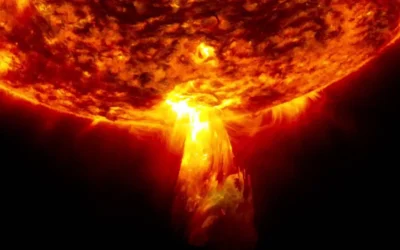Welcome to the captivating world of Charles Messier, a renowned French astronomer whose astronomical observations and discoveries have left an indelible mark on the field of astronomy. Born on June 26, 1730, in Badonviller, France, Messier’s fascination with the celestial realm began at an early age, triggered by awe-inspiring events like the appearance of a six-tailed comet and a rare annular solar eclipse.
Throughout his career, Messier dedicated himself to advancing our understanding of the cosmos, ultimately creating the iconic Messier catalogue. This remarkable catalogue consists of 110 nebulae and star clusters, collectively known as Messier objects. These deep-sky objects became a foundational resource for astronomers, enabling them to differentiate between transient visually diffuse objects and permanent celestial wonders.
Key Takeaways:
- Charles Messier was a French astronomer known for his creation of the Messier catalogue, which listed 110 nebulae and star clusters.
- His observations aimed to differentiate between permanent and transient visually diffuse objects in the sky.
- Messier’s interest in astronomy was sparked by witnessing celestial events like a six-tailed comet and an annular solar eclipse.
- He made significant contributions to the field throughout his career, cataloging 13 comets and refining astronomical observing techniques.
- The Messier catalogue remains a crucial tool for astronomers and continues to inspire further exploration of deep-sky objects.
The Early Life and Education of Charles Messier
Charles Messier, a renowned French astronomer, was born on June 26, 1730, in Badonviller, a charming town in the Lorraine region of France. Growing up as the tenth child among twelve siblings, Messier developed a fascination with the night sky from a young age.
The spark that ignited his interest in the cosmos came through witnessing significant celestial events. In 1744, Messier was captivated by the mesmerizing sight of a six-tailed comet, leaving an indelible impression on his young mind. Four years later, in 1748, he witnessed an annular solar eclipse, an awe-inspiring spectacle that further fueled his passion for the mysteries of the universe.
Under the guidance of Joseph Nicolas Delisle, the prominent astronomer of the French Navy, Messier’s early education and training were shaped to cultivate his passion for astronomy. Delisle instilled in him a meticulous approach to observing and recording celestial phenomena.
Although Messier’s upbringing in the idyllic countryside lacked formal academic opportunities, his curiosity and dedication led him to become one of the most significant figures in the field of astronomy. His humble beginnings forged a path towards a life of discovery, shaping his destiny as a meticulous observer of the night sky.
Charles Messier’s Contributions to Astronomy
Throughout his illustrious career as an astronomer, Charles Messier made significant contributions to the field, leaving behind a lasting legacy. While his discoveries spanned various celestial phenomena, it is his creation of the renowned Messier catalogue that remains his most enduring accomplishment. This catalog, consisting of 110 nebulae and star clusters, known as Messier objects, revolutionized the study of deep-sky objects.
Messier’s meticulous observations and recordings played a crucial role in helping astronomers differentiate between permanent celestial objects and transient visually diffuse objects. By meticulously documenting these observations, he paved the way for further advancements in the field of astronomy.
One of Messier’s notable achievements was his discovery and cataloging of 13 comets, including the famous Comet Halley in 1759. His detailed records and careful analysis contributed to a deeper understanding of these celestial wanderers and their behavior.
But it is the Messier catalogue that truly embodies Messier’s dedication and passion for celestial exploration. The catalog provided astronomers with a comprehensive reference, enabling them to identify and study deep-sky objects more effectively. Each Messier object in the catalog is designated with its specific number, such as M1 for the Crab Nebula, allowing for easy identification and further research.
These significant contributions by Charles Messier continue to shape the field of astronomy. His tireless work and meticulous approach have left an indelible mark on the scientific community, inspiring future generations of astronomers to further explore and understand the wonders of the universe.
Messier’s Discoveries
Messier’s dedication to astronomical observations led to the discovery of numerous celestial objects, enriching our understanding of the universe. In addition to the 13 comets he found, his catalog includes stunning nebulae and captivating star clusters. Some of his notable discoveries include:
- M31 (Andromeda Galaxy): The largest nearby galaxy, visible to the naked eye.
- M42 (Orion Nebula): A star-forming region and one of the brightest nebulae in the night sky.
- M45 (Pleiades): A mesmerizing open star cluster, often referred to as the Seven Sisters.
- M13 (Great Hercules Cluster): A globular cluster containing hundreds of thousands of stars.
- M57 (Ring Nebula): A planetary nebula with a distinctive ring-like structure.
These discoveries continue to captivate astronomers and stargazers alike, highlighting the profound impact of Messier’s contributions to the study of celestial objects.
The Messier Catalogue and Its Significance
The Messier catalogue, created by Charles Messier, is a compilation of 110 nebulae and star clusters. It provides detailed information about these celestial objects, including their location in the sky and their physical characteristics.
The Messier objects, often referred to by their Messier designation, such as M1 for the Crab Nebula, have become essential tools for astronomical observations. This catalogue is significant because it helped astronomers differentiate between permanent objects, such as galaxies and star clusters, and transient visually diffuse objects, such as comets.
The Messier catalogue, with its comprehensive collection of deep-sky objects, allows researchers and amateur astronomers to easily locate and study these fascinating celestial phenomena. It is a testament to Charles Messier’s dedication to documenting and cataloging the wonders of the universe.
The Messier Catalogue in Action
Here are a few examples of notable Messier objects:
- M1 – Crab Nebula: A supernova remnant located in the constellation Taurus.
- M42 – Orion Nebula: A bright emission nebula and stellar nursery in the constellation Orion.
- M45 – Pleiades: An open star cluster, often called the Seven Sisters, in the constellation Taurus.
These examples represent just a small fraction of the fascinating deep-sky objects cataloged by Charles Messier. The Messier catalogue continues to be a valuable resource for astronomers of all levels and a testament to the rich history and ongoing exploration of the universe.
Messier’s Observing Techniques and Instruments
Charles Messier, renowned astronomer, conducted his groundbreaking astronomical observations utilizing various techniques and instruments. A key instrument in his arsenal was a 100 mm (four-inch) refracting telescope, which he operated from the prestigious Hôtel de Cluny in Paris.
Through his meticulous measuring and methodical documentation, Messier employed observing techniques that revolutionized the field of astronomy. He recorded the precise positions and characteristics of celestial objects, capturing vital information about their brightness and size.
Over a span of several years, Messier’s dedicated observations led to the discovery and cataloging of numerous deep-sky objects, expanding our understanding of the universe. He meticulously observed and documented these celestial wonders, leaving a profound impact on the study of astronomy.
Messier’s Observing Techniques
Messier’s observing techniques focused on precise measurements and thorough documentation. By meticulously recording the positions and characteristics of celestial objects, he unearthed invaluable insights into the cosmos. Messier’s observations provided astronomers with detailed data to map and study these celestial wonders.
His notable techniques included:
- Accurate Measurements: Messier was meticulous in his measurements, employing the finest tools and techniques available during his time. His attention to detail ensured reliable and precise data.
- Systematic Documentation: Messier’s observations were carefully documented, noting the exact positions of celestial objects in the night sky. His comprehensive records offered future astronomers a treasure trove of information.
- Prolonged Observations: Messier’s commitment to his craft involved extended periods of observation, allowing him to witness and document celestial phenomena over time. This dedication allowed for the discovery of transient objects and provided valuable insights into their behavior.
Astronomical Instruments Used by Messier
In his pursuit of astronomical discovery, Charles Messier utilized various instruments to aid his observations and measurements. Alongside his trusted 100 mm (four-inch) refracting telescope, other instruments he employed included:
| Instrument | Description | Image |
|---|---|---|
| Equatorial Mount | An adjustable mount that enabled precise tracking of celestial objects. This tool allowed Messier to accurately follow the motion of stars and objects in the night sky. | https://www.youtube.com/watch?v=31m78KBbpIk |
| Star Charts and Atlases | Messier relied on detailed star charts and atlases to aid in identifying and locating celestial objects. These maps provided essential guidance during his observations. | https://www.youtube.com/watch?v=31m78KBbpIk |
| Chronometer | Messier utilized a precise chronometer to accurately measure time during his observations. This allowed him to note the exact moment of celestial events and track their duration. | https://www.youtube.com/watch?v=31m78KBbpIk |
These instruments, in conjunction with Messier’s expertise and meticulousness, culminated in groundbreaking discoveries that transformed our understanding of the universe.
Messier’s Discoveries and Contributions to Comet Hunting
Charles Messier, renowned astronomer, not only made significant contributions in cataloging nebulae and star clusters but also left a lasting impact on the field of comet hunting. Throughout his career, Messier discovered and observed 13 comets, showcasing his keen eye and dedication to astronomical observations.
With meticulous attention to detail, Messier’s observations and recordings of comets advanced our understanding of these celestial bodies. His work in comet hunting, in conjunction with his extensive study of nebulae and star clusters, solidified his reputation as one of the foremost experts in the field.
Messier’s Notable Comet Discoveries
| Comet Number | Comet Name | Date of Discovery |
|---|---|---|
| 1 | C/1760 B1 | January 23, 1760 |
| 2 | C/1760 A1 | January 7, 1760 |
| 3 | Great Comet of 1769 | August 8, 1769 |
| 4 | C/1771 G1 | April 14, 1771 |
| 5 | C/1771 A1 | January 9, 1771 |
Messier’s detailed records and observations have contributed significantly to our knowledge of comets and their behavior. By meticulously documenting their unique characteristics, he aided in advancing the study of these celestial wanderers.
Through his dedication and expertise, Charles Messier left a lasting legacy in the fields of astronomic observation and the study of deep-sky objects.
Charles Messier’s Legacy and Impact on Astronomy
Charles Messier’s contribution to the field of astronomy is unparalleled, leaving behind a rich astronomical legacy that continues to shape the study of deep-sky objects. His groundbreaking creation of the Messier catalogue revolutionized the way astronomers identify and explore celestial phenomena, providing a comprehensive reference for the astronomical community.
Messier’s meticulous observations and documentation set the gold standard for future astronomers, emphasizing the importance of careful record-keeping and precise measurements. His work not only advanced the field of astronomy during his time but also served as a foundation for further discoveries and advancements in our understanding of the universe.
The Messier catalogue, consisting of 110 nebulae and star clusters, remains an invaluable resource for astronomers worldwide. It stands as a testament to Messier’s commitment to documenting and categorizing deep-sky objects with precision and accuracy.
Through his pioneering efforts, Messier laid the groundwork for countless astronomers to further explore and study the wonders of the cosmos. He instilled a sense of curiosity and wonder in subsequent generations, inspiring them to delve deeper into the mysteries of the universe.
Today, the Messier catalogue serves as an indispensable tool for both amateur and professional astronomers, guiding their observations and providing insights into the vast expanse of the cosmos. It continues to facilitate groundbreaking research and further our knowledge of deep-sky objects.
Truly, the impact of Charles Messier’s work in astronomy history cannot be overstated. His dedication, meticulousness, and passion for exploration have left an indelible mark on the field, inspiring astronomers to reach for the stars and uncover the secrets of the universe.
| Charles Messier’s Legacy | Impact on Astronomy |
|---|---|
| Revolutionized the study of deep-sky objects | Provided a comprehensive reference for astronomers |
| Set a high standard for meticulous observations | Advanced the field of astronomy |
| Laid the groundwork for future discoveries | Fueled further advancements in our understanding of the universe |
| Inspired curiosity and wonder in subsequent generations | Instilled a passion for exploring the cosmos |
| Continues to be an invaluable resource for astronomers | Facilitates groundbreaking research |

Commemorations and Honors for Charles Messier
Charles Messier’s contributions to astronomy have left an indelible mark on the scientific community, leading to numerous commemorations and honors in recognition of his significant achievements. His work has revolutionized our understanding of the universe, particularly through the creation of the Messier catalogue, which continues to be a valuable resource for astronomers.
Messier’s name is immortalized through the enduring legacy of the Messier objects. These fascinating celestial phenomena, meticulously observed and cataloged by Messier himself, are constantly studied and appreciated by the astronomical community. The Messier objects represent a treasure trove of deep-sky wonders, captivating both amateur stargazers and seasoned professionals alike.
As a testament to Messier’s profound impact on the field of astronomy, he has been honored through the naming of a lunar crater, aptly named Messier. This lunar feature stands as a tribute to his pioneering spirit and tireless dedication to astronomical exploration.
In addition, an asteroid, 7359 Messier, also bears his name, further underscoring his enduring influence and contributions to the scientific world.
Charles Messier’s remarkable legacy lives on in the ongoing exploration and study of the Messier objects. His name has become synonymous with excellence in astronomy and has instilled a sense of awe and wonder in generations of astronomers. The astronomical community continues to celebrate Messier’s invaluable contributions and recognizes his unparalleled dedication to unraveling the mysteries of the cosmos.
Immerse yourself in the captivating world of Charles Messier and venture into the depths of the universe as you discover the remarkable Messier objects that continue to inspire and fascinate astronomers worldwide.
Historical Updates and Continued Research on Charles Messier
Over time, new historical evidence and research have contributed to a better understanding of Charles Messier’s life and contributions to astronomy. Ongoing astronomical research has shed light on previously little-known details, such as his years in Badonviller and his interactions with other astronomers of his time.
New biographical information and studies of his observations and discoveries continue to add to our understanding of Messier’s impact on the field of astronomy. These in-depth investigations into his life and work form the backbone of a comprehensive Messier biography, allowing us to delve deeper into the life and legacy of this remarkable astronomer.
Scholars and astronomers are dedicated to continued research on Charles Messier, driven by a passion to uncover and preserve his historical legacy. Through meticulous analysis of his observations, meticulous documentation, personal correspondences, and written manuscripts, researchers aim to present a more comprehensive picture of Messier’s life and contributions to astronomy.
| Research Findings | Details |
|---|---|
| Uncovering Personal Correspondences | Letters exchanged between Messier and his contemporaries reveal insights into his collaborations, challenges, and contributions to the astronomical community. |
| Exploring Unpublished Manuscripts | Archival discoveries have uncovered previously unknown manuscripts written by Messier himself, providing valuable insights into his thought process and methods. |
| Revisiting Observational Data | Advancements in astronomical technology and techniques allow researchers to reanalyze Messier’s observational data, yielding new insights and interpretations. |
| Examining Historical Context | Research on the historical context in which Messier operated helps shed light on the challenges and opportunities he faced during his career. |
Through ongoing historical updates and continued research, the legacy of Charles Messier remains a subject of fascination and exploration. The fruits of these endeavors not only deepen our understanding of his life but also contribute to the broader field of astronomy, ensuring that Messier’s contributions continue to inspire and inform future generations of astronomers.
Resources and References for Further Exploration of Charles Messier
For those interested in further exploring the life and work of Charles Messier, there are various resources available. Books, articles, and online references provide detailed information on Messier’s observations, discoveries, and contributions to astronomy. The Messier objects themselves offer a wealth of opportunities for amateur and professional astronomers to observe and study deep-sky objects. The ongoing research and scholarly work focused on Charles Messier ensure that his legacy continues to be explored and appreciated by the scientific community and astronomy enthusiasts.
Recommended Resources
- Book: “Charles Messier and the Discovery of the Messier Objects” by Neil English
- Online Article: “The Life and Legacy of Charles Messier” on Astronomy.com
- Website: The Messier Catalog (www.messiercatalog.com)
The above resources provide comprehensive information on Charles Messier’s observations, discoveries, and the significance of the Messier objects in the field of astronomy. They serve as valuable references for further research and exploration of deep-sky objects.
Observing the Messier Objects
To observe the Messier objects, astronomers can use telescopes of varying sizes, depending on their equipment and experience. Amateur astronomers can start with a beginner-friendly telescope, such as a 6-inch Dobsonian reflector, and gradually work their way up to larger instruments for a more detailed view of these deep-sky objects. Observing guides and star charts specific to the Messier objects are widely available in books and online resources, providing guidance on locating and identifying each object.
When observing the Messier objects, it’s important to plan your observation sessions away from light pollution and during clear, dark nights for optimal visibility. Take note of the specific coordinates and recommended viewing conditions for each object, as they may vary.
Further Research and Contributions
Charles Messier’s work and the Messier catalogue continue to inspire further research and contributions to the field of astronomy. Astronomers worldwide collaborate to refine the observations and characteristics of the Messier objects, documenting new findings and sharing their knowledge in scientific publications and conferences.
Amateur astronomers play a crucial role in observing and documenting the Messier objects. By reporting their observations and contributing to citizen science projects, they contribute to ongoing research and help deepen our understanding of these deep-sky treasures.
Conclusion
Charles Messier’s astronomical observations and the creation of the Messier catalogue have left an indelible legacy in the field of astronomy. His meticulous documentation and cataloging of deep-sky objects have significantly contributed to our understanding of the universe.
The Messier catalogue, consisting of 110 nebulae and star clusters, has become an invaluable resource for astronomers, providing a comprehensive reference for identifying and studying celestial phenomena. Messier’s work has enabled astronomers to differentiate between permanent objects, like galaxies and star clusters, and transient visually diffuse objects, such as comets.
Today, Messier’s legacy lives on as his catalog continues to inspire and guide astronomers in their exploration of the cosmos. His dedication to careful observations and documentation has set a high standard for future generations of astronomers, paving the way for further advancements in the field.
In recognition of Charles Messier’s incredible contributions to astronomy, his name has been immortalized through the Messier objects and honored through the naming of a lunar crater and an asteroid. His impact on the field of astronomy will continue to be celebrated and studied as we unravel the mysteries of the deep sky.
FAQ
Who was Charles Messier?
Charles Messier was a French astronomer known for creating the Messier catalogue, which listed 110 nebulae and star clusters, referred to as Messier objects.
What is the Messier catalogue?
The Messier catalogue is a compilation of 110 nebulae and star clusters, created by Charles Messier. It helps astronomers differentiate between permanent and transient visually diffuse objects in the sky.
What were Charles Messier’s contributions to astronomy?
Charles Messier made significant contributions to astronomy throughout his career. He discovered and cataloged 13 comets and created the Messier catalogue, revolutionizing the study of deep-sky objects.
What are the Messier objects?
The Messier objects are celestial entities listed in the Messier catalogue. They include nebulae and star clusters, such as the Crab Nebula (M1), and provide valuable information for astronomers studying deep-sky objects.
How did Charles Messier conduct his astronomical observations?
Charles Messier primarily used a 100 mm refracting telescope and employed meticulous measurements and careful documentation of his observations, noting the positions and characteristics of celestial objects.
Did Charles Messier make any discoveries in comet hunting?
Yes, Charles Messier discovered and observed 13 comets throughout his career, including Comet Halley in 1759. His recordings and observations advanced the understanding of these celestial objects.
What is Charles Messier’s legacy in the field of astronomy?
Charles Messier’s legacy in astronomy is significant. His creation of the Messier catalogue revolutionized the study of deep-sky objects, paving the way for future advancements and inspiring astronomers worldwide.
How has Charles Messier been honored?
Charles Messier has been honored through the naming of a lunar crater, Messier, and an asteroid, 7359 Messier. His name is also synonymous with excellence in the field of astronomy.
What ongoing research is being conducted on Charles Messier?
Ongoing research focuses on uncovering and preserving the historical legacy of Charles Messier. Scholars and astronomers continue to explore his life, observations, and contributions to further our understanding of his impact on astronomy.
Where can I find resources to learn more about Charles Messier?
Books, articles, and online references provide detailed information on Charles Messier’s observations, discoveries, and contributions to astronomy. Additionally, studying the Messier objects themselves offers valuable insights.






